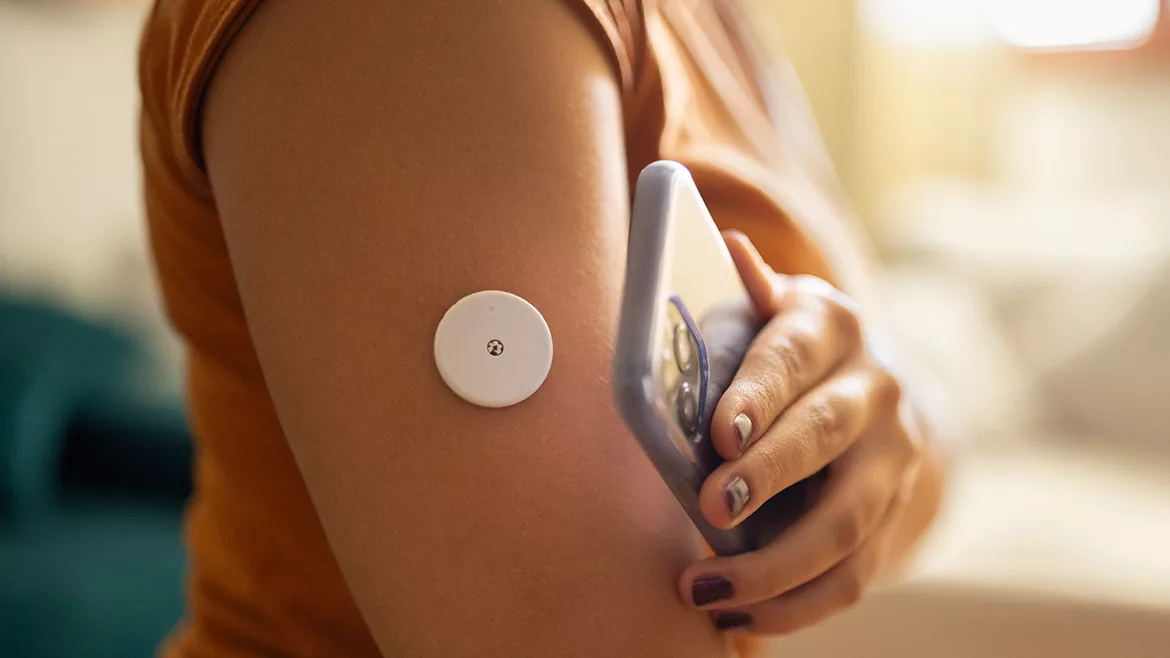New Coating Technology Extends Lifespan of Implantable Biosensors

Credit: miodrag ignjatovic / E+ via Getty Images
Wearable and implantable biosensors that can accurately detect biological molecules in a non- or minimally invasive manner have vast potential for monitoring patients’ physiology and response to therapies. For example, wearable glucose monitors that measure blood glucose levels and convert these measurements into readily readable and continuously recorded electrical signals have become indispensable in the management of diabetes patients. Similar biosensors have been developed for the monitoring of electrolytes in sweat, biomarkers in interstitial fluid near the skin surface, and to report on the function of internal tissues.
However, these implantable biosensor devices are only useful for a limited time because of a phenomenon known as “biofouling,” in which either bacteria, human cells, or diverse molecules contained in the body’s biofluids build up on the sensor surface, blocking its interaction with the target molecule (analyte) it is supposed to bind, thereby interfering with its electrical signal-generating mechanism. In addition, implanted biosensors can provoke so-called “foreign body responses” through the unwanted stimulation of nearby pro-inflammatory immune cells that can cause fibrotic tissue reactions.
Overcoming this challenge would open the door for many clinical diagnostic and research applications, such as longer-term steady-state monitoring of patients with chronic or autoimmune diseases; assessments of patients’ responses to existing therapies or new therapies tested in clinical trials; and measurements of physiological and pathological signals in many organs, including the brain.
Now, a multidisciplinary research team at the Wyss Institute at Harvard University has developed a new coating technology that holds promise to substantially increase the lifespan of implanted and wearable biosensors while retaining their electrical signaling activities, enabling continuous measurements of analytes in different biofluids inside the body potentially for many weeks. As demonstrated by the team, the coating, when overlaid on electrochemical sensor devices, inhibited the growth of Pseudomonas aeruginosa, a bacterial species responsible for the formation of antibiotic-resistant biofilms on biosensors and other implanted devices. The coating also prevented the adhesion of primary human fibroblasts and unwanted activation of immune cells in its vicinity, while keeping the detection capabilities of proof-of-concept sensors, designed to bind two prominent inflammatory proteins, fully functional over at least three weeks. Their findings are published in the journal Biosensors.
“With this novel coating technology, which can offer durable protection of implantable biosensor devices, we have removed a central bottleneck in the development of next-generation electrochemical in vivo sensors. In the age of personalized medicine and digital health, it brings a plethora of diagnostic and research applications within reach,” said Wyss Institute Founding Director Donald Ingber, M.D., Ph.D., who led the study. “It is also a testament to the laser-sharp focus of the Wyss’ electrochemical sensor team on solving problems that significantly slow progress in clinical care.” He also is the Judah Folkman Professor of Vascular Biology at Harvard Medical School and Boston Children’s Hospital, and the Hansjörg Wyss Professor of Biologically Inspired Engineering at the Harvard John A. Paulson School of Engineering and Applied Sciences.
The new coating technology builds on a tradition of highly innovative electrochemical biosensor developments at the Wyss Institute. Some of the platform’s innovations are currently commercialized by the Wyss-enabled startup StataDX, which develops assays to detect diverse molecular changes in the human brain using a drop of blood obtained from patients. However, to enable continuous electrochemical biomarker measurements in vivo over time periods spanning multiple weeks, first author Sofia Wareham-Mathiasen, Ph.D., and her co-workers on Ingber’s team created the new coating, which is composed of a cross-linked lattice of bovine serum albumin (BSA) and functionalized graphene. While the graphene component ensures efficient electrical signaling, the BSA lattice forms a natural barrier preventing unspecific binding of a large array of possible life and molecular contaminants; it also allows the stable inclusion of analyte-detecting antibodies in the coating, as well as antibiotic drugs that actively combat biofouling.
In their proof-of-concept study, the team demonstrated that they could continuously and accurately detect two important biomarkers of inflammation over more than three weeks, using specifically designed sensors that were exposed to complex human plasma. Over the same time interval, the coating resisted the attachment of human fibroblast cells and formation of biofilms usually produced by P. aeruginosa bacteria, while remaining inconspicuous to pro-inflammatory immune cells. Moreover, the coating can be fabricated from low-cost components in a simple, scalable process to facilitate the fabrication of in vivo biosensors in large quantities. The Wyss Institute has patented this novel coating technology and is looking for partners to facilitate its advancement into real-world applications to directly impact patients’ lives and scientific discovery.
Other authors on the study are former Wyss Senior Scientist Pawan Jolly, who was instrumental in advancing the Wyss’ electrochemical biosensor platform; industry collaborator Henrik Bengtsson at Novo Nordisk, and Thomas Bjarnsholt at the Costerton Biofilm Center of University of Copenhagen, Denmark; as well as Wyss researchers Nandhinee Radha Shanmugam, Badrinath Jagannath, Pranav Prabhala, Yunhao Zhai, Alican Ozkan, Arash Naziripour, and Rohini Singh.
For more information and to read the original article, click here.
This article was originally published by Harvard University's Wyss Institute and is reprinted with permission.
Looking for a reprint of this article?
From high-res PDFs to custom plaques, order your copy today!







